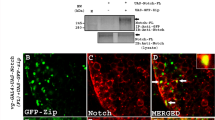Summary
Cell-cell interactions are involved in mediating developmental fate. An example is the decision of the neuroectodermal cells of Drosophila to develop as neural or epidermal progenitors, where cellular interactions participate in the process of acquisition of either cell fate. The results of heterochronic cell transplantations we describe here suggest that both neuroblasts and epidermoblasts are not irreversibly committed to a particular developmental fate. Rather, they retain the ability to interact with neighbouring cells and, under our experimental conditions, are capable of switching their fate during a relatively long period of time, i.e. until the end of embryonic stage 11.
Similar content being viewed by others
References
Beer J, Technau GM, Campos-Ortega JA (1987) Lineage analysis of transplanted individual cells in embryos of Drosophila melanogaster. IV. Commitment and proliferative capabilities of mesodermal cells. Roux's Arch Dev Biol 19:222–230
Campos-Ortega JA (1985) Genetics of early neurogenesis in Drosophila melanogaster. Trends Neurosci 8:245–250
Campos-Ortega JA, Hartenstein V (1985) The embryonic development of Drosophila melanogaster. Springer Verlag, Berlin Heidelberg New York Tokyo, p 227
Campos-Ortega JA, Bremer KA, Concha A de la, Dietrich U, Knust E, Technau GM, Tietze K, Vässin H, Ziemer A (1987) Genetische Analyse der frühen Neurogenese bei Drosophila melanogaster. Verh Dtsch Zool Ges 80:9–22
de la Concha A, Dietrich U, Weigel D, Campos-Ortega JA (1988) Functional interactions of neurogenic genes of Drosophila melanogaster. Genetics 118:499–508
Doe CQ, Goodman CS (1985) Early events in insect neurogenesis. II. The role of cell interactions and cell lineages in the determination of neuronal precursor cells. Dev Biol 111:206–219
Ferguson EL, Sternberg PW, Horvitz HR (1987) A genetic pathway for the specification of the vulval cell lineages of Caenorhabditis elegans. Nature 326:259–267
Foe V, Alberts B (1983) Studies of nuclear and cytoplasmic behaviour during the five mitotic cycles that precede gastrulation in Drosophila embryogenesis. J Cell Sci 61:31–70
Hartenstein V, Campos-Ortega JA (1984) Early neurogenesis in wildtype Drosophila melanogaster. Roux's Arch Dev Biol 193:308–325
Hartenstein V, Campos-Ortega JA (1985) Fate mapping in wildtype Drosophila melanogaster. I. The pattern of embryonic cell divisions. Roux's Arch Dev Biol 194:181–195
Hartenstein V, Rudloff E, Campos-Ortega JA (1987) The pattern of proliferation of the neuroblasts in the wild-type embryo of Drosophila melanogaster. Roux's Arch Dev Biol 196:473–485
Ho RK, Weisblat DA (1987) A provisional epithelium in leech embryo: cellular origins and influence on a developmental equivalence group. Dev Biol 120:520–534
Kidd S, Kelley MR, Young MW (1986) Sequence of the Notch locus of Drosophila melanogaster: Relationship of the encoded protein to mammalian clotting and growth factors. Mol Cell Biol 6:3094–3108
LaBonne SG, Mahowald SP (1985) Partial rescue of embryos from two maternal-effect neurogenic mutants by transplantation of wildtype ooplasm. Dev Biol 110:264–267
Lehmann R, Jimenez F, Dietrich U, Campos-Ortega JA (1983) On the phenotype and development of mutants of early neurogenesis in Drosophila melanogaster. Roux's Arch Dev Biol 192:62–74
Poulson DF (1950) Histogenesis, organogenesis and differentiation in the embryo of Drosophila melanogaster. In: Demerec M (ed) Biology of Drosophila. John Wiley, New York, pp 168–274
Shankland M, Weisblat DA (1984) Stepwise commitment of blast cell fates during the positional specification of the O and P cell fates during serial blast cell divisions in the leech embryo. Dev Biol 106:326–342
Shannon M (1972) Characterization of the female sterile mutant almondex of Drosophila melanogaster. Genetica 43:244–256
Stent GS (1985) The role of cell lineage in development. Philos Trans R Soc Lond [Biol] 312:3–19
Taghert PH, Doe CQ, Goodman CS (1984) Cell determination and regulation during development of neuroblasts and neurones in grasshopper embryos. Nature 307:163–165
Technau GM (1986) Lineage analysis of transplanted individual cells in embryos of Drosophila melanogaster. I. The method. Roux's Arch Dev Biol 194:196–212
Technau GM (1987) A single cell approach to problems of cell lineage and commitment during embryogenesis of Drosophila melanogaster. Development 100:1–12
Technau GM, Campos-Ortega JA (1985) Fate mapping in wildtype Drosophila melanogaster. II. Injetions of horseradish peroxidase in cells of the early gastrula stage. Roux's Arch Dev Biol 194:196–212
Technau GM, Campos-Ortega JA (1986a) Lineage analysis of transplanted individual cells in embryos of Drosophila melanogaster. II. Commitment and proliferative capabilities of neural and epidermal cell progenitors. Roux's Arch Dev Biol 195:445–454
Technau GM, Campos-Ortega JA (1986b) Lineage analysis of transplanted individual cells in embryos of Drosophila melanogaster. III. Commitment and proliferative capabilities of pole cells and midgut progenitors. Roux's Arch Dev Biol 195:489–498
Technau GM, Campos-Ortega JA (1987) Cell autonomy of expression of neurogenic genes of Drosophila melanogaster. Proc Natl Acad Sci USA 84:4500–4504
Vässin H, Bremer KA, Knust E, Campos-Ortega JA (1987) The neurogenic locus Delta of Drosophila melanogaster is expressed in neurogenic territories and encodes a putative transmembrane protein with EGF-like repeats. EMBO J 6:3431–3440
Weisblat DA, Blair SS (1984) Developmental indeterminacy in embryos of the leech Helobdella triserialis. Dev Biol 101:326–335
Wharton KA, Johansen KM, Xu T, Artavanis-Tsakonas S (1985) Nucleotide sequence from the neurogenic locus Notch implies a gene product that shares homology with proteins containing EGF-like repeats. Cell 43:567–581
Author information
Authors and Affiliations
Rights and permissions
About this article
Cite this article
Technau, G.M., Becker, T. & Campos-Ortega, J.A. Reversible commitment of neural and epidermal progenitor cells during embryogenesis of Drosophila melanogaster . Roux's Arch Dev Biol 197, 413–418 (1988). https://doi.org/10.1007/BF00398992
Received:
Accepted:
Issue Date:
DOI: https://doi.org/10.1007/BF00398992




